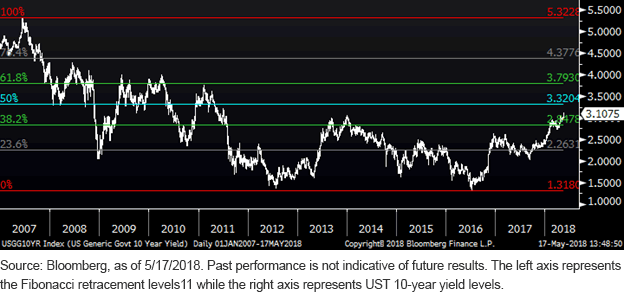WisdomTree launched its first ETFs in June of 2006, pioneering the concept of fundamental weighting. WisdomTree sponsors distinct ETFs that span asset classes and countries around the world.
U.S. Treasuries: Break On Through to the Other Side
Last Tuesday, May 15, represented a red-letter day for the U.S. Treasury (UST) market, as the 10-Year yield moved above a key technical level and ended up posting its highest numbers since 2011. The natural question is: Now that the UST 10-Year yield has achieved this breakthrough to the other side, where can it go from here?
In prior blog posts, I have highlighted the Fibonacci technical analysis as a useful tool. This tool displays percentage lines that look at support and resistance levels, potentially signaling price/ yield reversals. The concept of retracement suggests that after a period of market movement, prices/yields can retrace a prior pattern before returning to their original trend.
Prior to May 15, I was utilizing the five-year Fibonacci tool. In January of this year, the UST 10-Year yield level broke through the five-year Fibonacci 76.4% retracement level of 2.64%, a key development in its own right, as this level had proven to be difficult to penetrate up to that point. According to this analysis, the next stop to the upside, which would be a 100% retracement, was at 3.05%. So, while a great deal of media focus was centered on the 3% threshold, for those of us in bond-land, the key number was actually five basis points (bps) higher.
Now that the 3.05% level has been breached, one has to go back to the drawing board a bit. A first approach would be to utilize 2011 as the starting point, since that was the last time, the UST 10-Year yield was this high. Using this time frame, the next retracement level would be roughly 3.19%, representing the aforementioned 76.4% line. For the record, the 100% retracement figure rounds out to 3.77%.
I find it more insightful to go back further in time. Indeed, by elongating the analysis, I believe investors can see a wider perspective. Against this backdrop, the analysis would go back to the beginning of 2007, or before the financial crisis and great recession . As was the case with 2011 as a starting point, both studies show 1.32% (rounded) as the 0% level, but for the 2007 analysis, the 100% retracement level is 5.32%. Notably, the 50% retracement line in this case stands at 3.32%, which may prove to be the next level in play.
Conclusion
At some point, this breakout in rates needs to be validated. Indeed, the UST market has seemingly now discounted, or allowed for a lot of negative news (stronger economic growth and higher inflation expectations). Certainly, burgeoning Treasury supply needs and the Federal Reserve (Fed) pulling back on its Treasury purchases are factors that will remain a part of the rate landscape, but the other two legs of the tripod represent a data-dependent aspect to the outlook. While a potential path toward a 3.25%–3.30% level may not always be a one-way street, in my opinion, the 2007 Fibonacci analysis helps put UST 10-Year yield possibilities in some perspective. Stay tuned, it’s still only May!
Unless otherwise stated, data source is Bloomberg, as of May 17, 2018.
RSS Import: Original Source
Investors should carefully consider the investment objectives, risks, charges and expenses of the Funds before investing. U.S. investors only: To obtain a prospectus containing this and other important information, please call 866.909.WISE (9473), or click here to view or download a prospectus online. Read the prospectus carefully before you invest. There are risks involved with investing, including the possible loss of principal. Past performance does not guarantee future results.
You cannot invest directly in an index.
Foreign investing involves currency, political and economic risk. Funds focusing on a single country, sector and/or funds that emphasize investments in smaller companies may experience greater price volatility. Investments in emerging markets, real estate, currency, fixed income and alternative investments include additional risks. Due to the investment strategy of certain Funds, they may make higher capital gain distributions than other ETFs. Please see prospectus for discussion of risks.
WisdomTree Funds are distributed by Foreside Fund Services, LLC, in the U.S. only.



